
Pogona is a genus of reptiles containing eight lizard species, which are often known by the common name bearded dragons. The name "bearded dragon" refers to the underside of the throat of the lizard, which can turn black and become inflated for a number of reasons, most often as a result of stress, if they feel threatened, or are trying to entice a mate. They are a semiarboreal species, spending significant amounts of time on branches, in bushes, and near human habitation. Pogona species bask on rocks and exposed branches in the mornings and afternoons and sleep at night, making them a diurnal species. Their diet consists primarily of vegetation and some insects. They are found throughout much of Australia and inhabit environments such as deserts, and shrublands.

Phrynosoma, whose members are known as the horned lizards, horny toads, or horntoads, is a genus of North American lizards and the type genus of the family Phrynosomatidae. Their common names refer directly to their horns or to their flattened, rounded bodies, and blunt snouts.
Raw feeding is the practice of feeding domestic dogs, cats, and other animals a diet consisting primarily of uncooked meat, edible bones, and organs. The ingredients used to formulate raw diets vary. Some pet owners choose to make home-made raw diets to feed their animals but commercial raw diets are also available.

Tomato frogs are any of the three species of genus Dyscophus : D. antongilii, D. insularis, or D. guineti. Dyscophus is the only genus in subfamily Dyscophinae. They are endemic to Madagascar.

Bitis nasicornis is a viper species belonging to the genus Bitis, part of a subfamily known as "puff-adders", found in the forests of West and Central Africa. This large viper is known for its striking coloration and prominent nasal "horns". No subspecies are currently recognized. Its common names include butterfly viper, rhinoceros viper, river jack and many more. Like all other vipers, it is venomous.
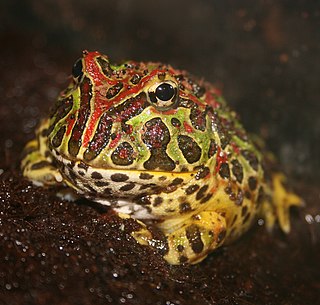
The Argentine horned frog, also known as the Argentine wide-mouthed frog, ornate horned frog, ornate horned toad, ornate pacman frog, or just the pacman frog is a species of frog in the family Ceratophryidae. The species is endemic to South America. It is the most common species of horned frog, in the grasslands of Argentina, Uruguay and Brazil. A voracious eater, it will attempt to swallow anything that moves close to its wide mouth, such as insects, rodents, lizards, and other frogs, even if this predator would suffocate in the process. It is also kept as an exotic pet. The nickname "pacman frog" is a reference to the popular 1980's arcade game Pac-Man, where Pac-Man himself eats quite a lot, and has a mouth that takes up most of its body, much like the Argentine horned frog.

African dwarf frog is the common name for members of Hymenochirus, a genus of aquatic frog native to parts of Equatorial Africa. They are common in the pet trade and are often mistaken for the African clawed frog, a similar-looking frog in the same family. African dwarf frogs. Their common name is obtained from their place of origin and the claws on their hind legs.

The common goldfish is a breed of goldfish and a family of Cyprinidae in the order cypriniformes. Goldfish are descendants of wild carp from East Asia. Most varieties of fancy goldfish were derived from this simple breed. Common goldfish come in a variety of colors including red, orange, red/white, white/black, yellow/white, blue, grey/brown, olive green, yellow, white, and black, with the most common variation being orange, hence the name. The brightness, duration, and vividness of the color may be an indication of the fish's health status, but not always, as water conditions and quality of care affect the fish's appearance.

Leipzig Zoological Garden, or Leipzig Zoo is a zoo in Leipzig`s district Mitte, Germany. It was first opened on June 9, 1878. It was taken over by the city of Leipzig in 1920 after World War I and now covers about 27 hectares and contains approximately 850 species. By 2020, the zoo featured six different theme worlds, aiming at providing habitats appropriate for the species on display.
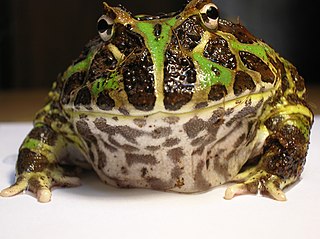
The Ceratophryidae, also known as common horned frogs, are a family of frogs found in South America. It is a relatively small family with three extant genera and 12 species. Despite the common name, not all species in the family have the horn-like projections at the eyes. They have a relatively large head with big mouth, and they are ambush predators able to consume large prey, including lizards, other frogs, and small mammals. They inhabit arid areas and are seasonal breeders, depositing many small eggs in aquatic habitats. Tadpoles are free-living and carnivorous or grazers (Chacophrys).

Ceratophrys is a genus of frogs in the family Ceratophryidae. They are also known as South American horned frogs as well as Pacman frogs due to their characteristic round shape and large mouth, reminiscent of the video game character Pac-Man.

The golden poison frog, also known as the golden dart frog or golden poison arrow frog, is a poison dart frog endemic to the rainforests of Colombia. The golden poison frog has become endangered due to habitat destruction within its naturally limited range. Despite its small size, this frog is considered to be the most poisonous extant animal species on the planet.
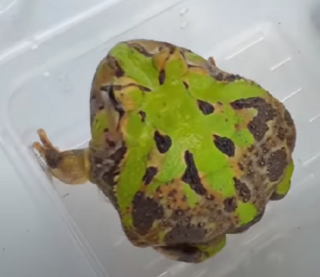
The Brazilian horned frog is a species of frog in the family Ceratophryidae. It is endemic to Brazil. Its natural habitats are subtropical or tropical moist lowland forest, freshwater marshes, intermittent freshwater marshes, and ponds.
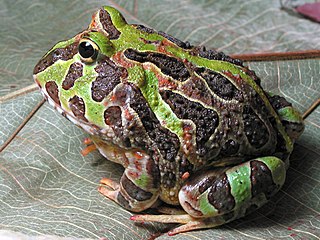
The Pacific horned frog, also known as Pacific big-mouthed frog, Stolzmann's horned frog and Ecuadorian horned frog, is a species of frog in the family Ceratophryidae. It is found in Ecuador and Peru. Its natural habitats are subtropical or tropical dry forest, subtropical or tropical dry shrubland, and sandy shores. Its geographical range is very fragmented; it has a total area of about 20,000 km2 and is continuously shrinking due to human activities.
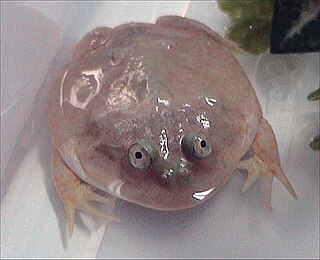
Lepidobatrachus laevis, widely known as Budgett's frog, is a species of frog in the family Ceratophryidae, discovered by John Samuel Budgett. It is often kept as a pet. It has acquired a number of popular nicknames, including hippo frog, Freddy Krueger frog, and escuerzo de agua.

The African bullfrog, also known as the Giant bullfrog or the South African burrowing frog, is a species of frog in the family Pyxicephalidae. It is also known as the pixie frog due to its scientific name. It is found in Angola, Botswana, Kenya, Malawi, Mozambique, Namibia, South Africa, Tanzania, Uganda, Zambia, Zimbabwe, and possibly the Democratic Republic of the Congo. It has been extirpated from Eswatini. It has long been confused with the edible bullfrog, and species boundaries between them, including exact range limits, are not fully understood. Additionally, P. angusticeps of coastal East Africa only was revalidated as a separate species in 2013.

Beelzebufo is a particularly large species of prehistoric frog described in 2008. Common names assigned by the popular media include devil frog, devil toad, and the frog from hell.

The northern caiman lizard is a species of lizard found in northern South America.

Tropicarium Kolmården is a public aquarium and terrarium, situated outside Kolmården Wildlife Park, close to Bråviken and 25 km (16 mi) from Norrköping town in Sweden. Kolmården Tropicarium is one of Sweden's largest tropical exhibitions with a covered area in excess of 2,000 m2 (22,000 sq ft).
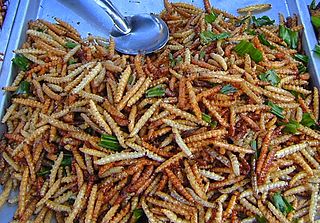
The welfare of farmed insects concerns treatment of insects raised for animal feed, as food or pet food, and other purposes such as honey and silk.





















